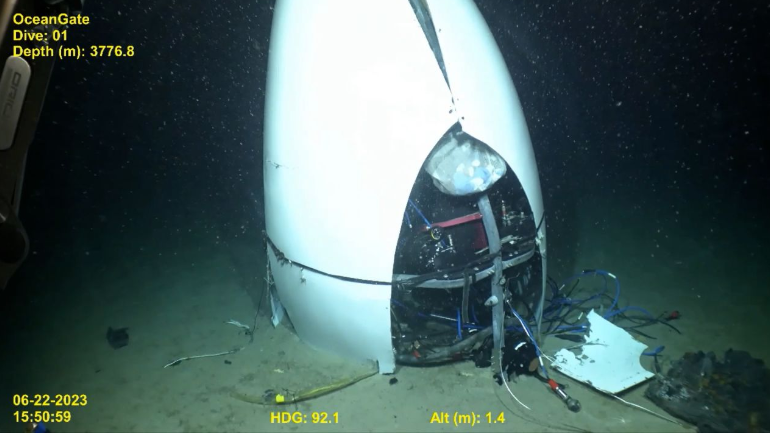Killing the five people onboard, the submersible referred to as Titan imploded during a dive to see the Titanic. Stockton Rush, the CEO of Oceangate, the company that created the sub, was one of the victims of the incident. He allegedly mismanaged the company, leading to the disaster.
The National Transportation Safety Board began an investigation with the Coast Guard into the incident. They opened a hearing in September to delve into the causes of the implosion.
“Several anomalies within the composite and the adhesive joints, including waviness, wrinkles, porosity and voids,” Don Kramer, the Chief of the National Transportation Safety Board Material Laboratory, said of an analysis of the manufacturing material the sub was made out of.
Remnants of the vessel were recovered from the ocean floor. Analysis from Kramer’s team revealed “waviness and wrinkles within the hull layers” and some empty spaces where adhesives should have held those layers together. They also found evidence of abrasion in those adhesive layers. It is unknown, however, whether those anomalies preceded the implosion or resulted from it.
Another major issue that emerged during the hearing was about Dive 80. Dive 80 was a dive conducted in 2022, where an incident occurred when the Titan rose to the surface. Passengers onboard the sub heard a loud bang, which the Titan’s monitoring system detected. During later dives, the sensors on board also detected a change in how the hull responded to strain.
The alteration “persisted from dive to dive,” Kramer said.
Oceangate’s former engineering director Phil Brooks noticed this discrepancy, but decided that it was normal. Rush decided to continue dives, and according to Brooks, Rush thought it was just the frame “readjusting back to its original shape.
Concerns about OceanGate’s operations had been growing in the industry before 2018. A group called the Marine Technology Society (MTS) decided to warn Rush about his recklessness. The letter they wrote contained a number of complaints, foremost that the submarine wasn’t classed according to safety standards, despite what Oceangate’s website implied. MTS feared the industry’s excellent safety track record could be marred due to Oceangate’s lack of adherence to industry standards
“Our members are all aware of how important and precious this standing is and [are] deeply concerned that a single negative event could undo this,” the letter reads.
OceanGate’s website implied that the sub met those standards, despite that not being the case.
“Your representation [on your website] is, at minimum, misleading to the public and breaches an industry-wide professional code of conduct we all endeavor to uphold,” the letter added.
OceanGate’s defense was that their sub was so innovative that it would be difficult and time-consuming to class the Titan and this prevented them from actually testing it. “Bringing an outside entity up to speed on every innovation before it is put into real-world testing is anathema to rapid innovation,” they wrote.
The chairman of MTS, William Kohnen, said that their letter was a cautionary message to Rush about his disregard for industry norms.
“We have a record of 50 years without a single fatality until Titan,” Kohnen said, adding, “It does indicate the power of our regulation,” Kohnen added.
“This letter was basically asking them to please do what the other submarines do, especially the passenger ones,” Bart Kemper, an engineer at a consulting firm that analyzed the disaster, said.
Kemper also mentioned that OceanGate was testing Titan in international waters to evade Coast Guard regulations applicable in US waters.
The Kemper Engineering analysis also noted concern about the lack of design life for the sub. There was no specified number of dives that would be completed before the sub had to be refurbished. When Rush was asked about the sub’s design life, Rush described it as “indefinite.”
Mr. Kemper pressed that this idea of a sub without an intended design life was a recipe for disaster. “It’s flat wrong,” Kemper said. “You don’t get a second chance.”





















